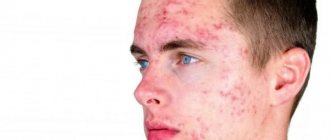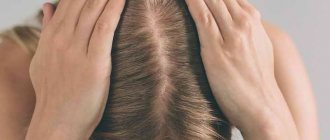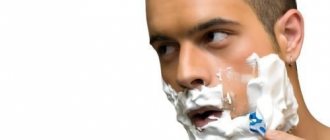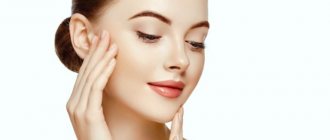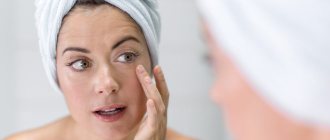Dandruff is a very common problem that, according to statistics, every fifth person on the planet faces and everyone asks themselves the question: “How to get rid of dandruff?”
Typically, scalp cells are replaced approximately every 28 days, but for some reason the upper stratum corneum of the skin begins to renew more quickly and unevenly, and dead cells accumulate on the surface, forming dandruff flakes.
Most often, this problem is a symptom of some kind of disorder in the body.
Causes
Where does dandruff come from:
- Dysfunction of the sebaceous glands
- Stress, nervous tension, lack of sleep and rest
- Improper hair care (for example, overuse of blow-drying, hairsprays, gels, coloring), which leads to dry scalp.
- Endocrine diseases (for example, dandruff can occur due to hormonal imbalance caused by increased levels of androgens).
- Poor and unbalanced nutrition
- Dysfunction of the gastrointestinal tract (gastrointestinal tract)
- Vitamin deficiency and its variety hypovitaminosis (most often due to a lack of vitamins A and B)
- Fungi and bacteria, which are part of the natural flora of the skin, but begin to multiply under unfavorable conditions (decreased immunity, stress, unfavorable environmental conditions, etc.)
Read on our website: shampoo for normal hair.
Dandruff and itchy scalp? Treatment with apple cider vinegar on this page.
How to get rid of hair loss, see here
Air touch – coloring technique at the link
Dandruff - what is it?
Many people don't consider it a problem and often ignore it altogether. Everyone should know that dandruff is a type of pathology in the functioning of the epithelial glands. The causative agent of the disease is the fungus Pityrosporum ovale. It spreads throughout the entire scalp quite quickly.
In most cases it causes discomfort in a person. Symptoms of manifestation are the appearance of white scales (small crumbs) on the hair, itching and burning, headache, irritation of the skin. Ignoring these manifestations will lead to negative consequences, such as seborrheic dermatitis. As a result, the person goes bald forever.
The amount of white scales (small crumbs) constantly increases as the disease progresses. It is visible not only on the hair itself, but also on the shoulders, clothes, etc., as it falls on the scalp. These scales are noticed not only by the sick themselves, but also by strangers. Its manifestation violates the aesthetic appearance of a person. One gets the feeling that he always has a dirty, unwashed head.
The intensity of itching and burning gradually increases. This occupies all the patient's thoughts. He loses concentration and attention, scratches his head. As a result, irritation of the upper layer of the epidermis occurs. In this case, Pityrosporum ovale is often associated with another bacterial infection.
Important! The problem is also characterized by headaches. Discomfortable sensations disrupt sleep, sleep and rest patterns. As a result, the patient has other problems - fatigue, irritability, absent-mindedness, loss of strength, etc.
Types of dandruff
There are several types of dandruff
Dry
Signs:
- Small scales, usually appearing on dry skin, are located throughout the head or predominantly in the fronto-parietal areas.
- Often accompanied by itching.
Fat
With hair loss (also often accompanied by thinning and split ends).
Main reasons:
- neuroendocrine disorders
- disruption of gastrointestinal tract functions
- avitaminosis
- poor nutrition
No hair loss
Main reasons:
- hypovitaminosis
- sensitivity of the scalp (allergic dermatitis).
Signs:
large oily scales, usually accompanied by acne and hair loss.
Main reasons:
dysfunction of the sebaceous glands - their increased work.
This type of dandruff is more difficult to treat and is often impossible without the intervention of a specialist.
Causes of dandruff
To get rid of “snow flakes” on your clothes and hair, you first have to identify the cause of this disease. A lack of understanding of where the problem came from leads to the fact that seborrhea can become an unwanted and unpleasant companion for a person for a long time. Only by identifying and eliminating the provoking factor can you be cured. Causes of dandruff can be:
- Chronic metabolic disorder;
- Serious diseases of internal organs: it is worth checking the functioning of the stomach and thyroid gland;
- Avitaminosis;
- Hormonal imbalance, which can be caused by puberty in adolescents, menopause, pregnancy or taking hormonal drugs in women;
- Reduced immunity;
- Problems with the nervous system are a common cause of dandruff: this is caused by depressive and stressful conditions, nervousness, chronic fatigue syndrome, emotional burnout;
- Hereditary predisposition, which determines the individual characteristics of the skin structure;
- Poor nutrition: passion for fast foods, fatty and spicy foods, carbonated drinks and coffee can also cause the appearance of “white flakes”;
- Hypothermia: dandruff affects those who walk in the cold season without a hat or swim in cold water without a special cap;
- Overheating: exposure of the scalp to high temperatures leads to the detachment of its scales, so seborrhea is the lot of those beauties who abuse curling irons, curling irons, hair dryers, flat irons, and thermal curlers;
- Allergy: often the skin reacts with dandruff in response to the material of the headgear, especially if it is synthetic;
- Incorrectly selected cosmetic products: their frequent changes, inconsistency with the type of skin and hair, different lines and manufacturers, their excessive use - all this disrupts the functioning of the sebaceous glands and worsens the condition of the scalp.
Once the causes are identified, all possible measures must be taken to eliminate them. For some, it is enough to buy inexpensive shampoo with menthol to forget about this scourge.
Someone will have to take care of their lifestyle, starting with improving their nutrition and ending with restoring their mental balance. If the reasons are too serious or there are difficulties in identifying them, you will need to seek help from a specialist. Unfortunately, most often people do not find time (or money) for this and suffer from seborrhea all their lives.
How to get rid of dandruff on your head
To treat dandruff it is necessary to determine:
- type of dandruff
- the most likely reason
Note: but most likely only a specialist can determine the exact cause.
For more effective and rapid treatment of dandruff, an integrated approach is required:
- selection of anti-dandruff shampoo and other cosmetics (sprays, balms)
- hair masks and infusions for rinsing against dandruff and itching
- physiotherapy, such as head massage (for example, cryomassage), darsonvalization of the scalp.
- a balanced diet enriched with vitamins (include foods with vitamins A and B in the diet);
- medications.
To completely get rid of dandruff, it is not enough to relieve the symptoms; it is important to eliminate the cause of its appearance.
Anti-dandruff shampoo
Here are some rules for using medicated anti-dandruff shampoo:
- it is selected individually, using a trial method (if after 3 weeks there are no noticeable improvements, you need to change the shampoo). It is best if it is selected by a trichologist.
- using only one shampoo to treat dandruff is sufficient only in advanced cases;
- You cannot use it constantly; when the effect is achieved, you must alternate it with regular shampoo.
There are several types of medicated anti-dandruff shampoos:
- Exfoliating
- Active ingredient:
sulfur and/or salicylic acid, which promote deep peeling - Example:
Klorane for dry dandruff with nasturtium, Squaphane S.
- Antifungal
- Active substance:
ketoconazole, tar, etc. - Example:
Nizoral, Sebozol, Dermazol
- Antibacterial
- Active substance
: zinc pyrithione, octopirox, etc. - Example
: Instant Clear by L'Oreal Professionnel
- With plant extracts
- Active ingredient
: ichthyol, tea tree oil, guava, lavender oil, rosemary, nettle, etc. - Example
: Home Institut against dandruff with nettle, Dandruff Control Shampoo
Read on our website: folk remedies for hair loss.
How to dye your hair with henna and basma? Read here.Ombre on short hair link
Getting rid of dandruff - folk remedies
Medicines prepared from natural, available ingredients help only in combination with medications, as a preventive measure against fungus or at its initial stage of development. Any folk or home method in most cases does not give a long-term effect, and over time the disease returns again. Partially they help people with good immunity. Popularized folk remedies in the fight against Pityrosporum ovale:
- apple cider vinegar (used as a conditioner - rinse, rich in vitamins, exfoliates dead cells, participates in the process of restoring the normal structure of the epidermis);
- table, Himalayan or sea salt (rubbed with massage movements into the scalp moistened with water before regular hair washing; has an antibacterial effect);
- ginger root juice (also rubbed into the scalp, the treatment method has a bactericidal effect, stimulates blood flow, hair growth, nourishes epidermal cells with vitamins);
- baking soda (add 1 tbsp to regular shampoo with a capacity of 250 ml, more often used as a preventive measure or if there is a tendency to become infected with a fungus);
- liquid acacia honey (used as a mask, contains a natural antibiotic, helps relieve pain, itching and burning).
Kefir 2.5% fat is also used as a mask. It is applied after shampooing to damp hair for 40-50 minutes. Then wash off with warm water. Suitable for dry and oily dandruff.
Important! Before using traditional methods, tests should be carried out.
Apply a small amount of medicine to a clean area of the body and wait 20-30 minutes. Then wash it off. If redness, itching, and rash do not appear in this area within 24 hours, then it can be used.
How to get rid of oily dandruff:
Decoction for rinsing against oily dandruff
Ingredients: decoction of St. John's wort, burdock, hops, sage, oregano, calendula, nettle Preparation: mix in the ratio 3:3:2:3:2:3:4
Application: rinse your hair after washing.
Calamus roots
Ingredients: calamus roots
Preparation:
- Pour 2 tablespoons into 1 liter of hot water,
- cook over low heat for 15 minutes,
- strain, cool
Application: rinse your hair with the solution once a week.
Lemon decoction
Ingredients: peel of four lemons Preparation: boil the peel in a liter of water for 15 minutes Application: rinse your hair with the solution once a week.
Dry dandruff how to get rid of
If you are tormented by dry dandruff. Try to get rid of it with the following remedies that are great for dry scalp:
Decoction-Infusion of tansy
- Nettle (suitable for quick treatment of oily dandruff on the scalp)
- Daisies
- Sage
- St. John's wort
Components: tansy stems and flowers.
Preparation: pour 1 tablespoon with a glass of boiling water and leave for 2 hours
Application: rinse your hair after washing every other day (10-12 times).
Beetroot water and bread
Ingredients: beets, stale rye bread
Preparation :
- Pour 1.5 liters of water into a 3-liter jar
- Peel, cut the beets and fill the jar until the water rises to the neck
- Place on the windowsill for 6 days until green mold appears (don’t let this bother you)
- Strain through cheesecloth, dilute with hot water
- Crumble 100g of bread, pour boiling water over it and lather your hair with this mixture
- Rinse with clean water
- Rinse with beetroot
Application: rinse your hair with the solution once a week.
